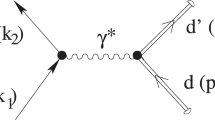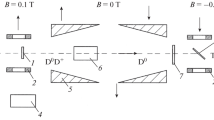Abstract
The deuteron beam vector polarization was obtained at the Nuclotron Internal Target Station using proton-proton quasielastic scattering on the polyethylene target at the beam energies of 200, 500, 550, and 650 MeV/nucleon. The proton beam polarization was obtained at the beam energy of 500 MeV. The selection of useful events was performed using the time and amplitude information from the scintillation counters and the subtraction of the carbon background, both for the deuteron and proton beams.
Similar content being viewed by others
Explore related subjects
Discover the latest articles, news and stories from top researchers in related subjects.Avoid common mistakes on your manuscript.
INTRODUCTION
Experiments to study proton-proton and deuteron-proton scattering are fundamental for understanding of the nucleon-nucleon interaction. At the same time, the study of spin effects at accelerators requires continuous monitoring of the beam polarization during the experiments. For this purpose, the polarimeter based on the asymmetry measurement of the deuteron-proton elastic scattering has been developed and installed at the Nuclotron Internal Target Station [1]. This polarimeter is designed to measure vector and tensor polarization of a deuteron beam using polyethylene and carbon targets.
The part of the detectors of this polarimeter was used to carry out tests of another classical method of the beam polarization measurement, which uses the asymmetry of quasielastic proton-proton scattering [2]. The comparison of the analyzing power of elastic and quasi-elastic pp-scattering shows that they are the same within achieved experimental accuracy over a large energy range [3]. This allows one to measure both the polarization of the proton beam and the vector polarization of the deuteron beam, since the counters are installed in accordance with pp-elastic scattering kinematics.
The purpose of this article is to present the data on the measurements of the vector polarization of the deuteron beam at different energies using the asymmetry of the pp-quasielastic scattering and the polarization of the proton beam at the energy of 500 MeV using pp-elastic scattering.
EXPERIMENT AND EVENT SELECTION
The beams of polarized deuterons and protons for Nuclotron were provided by the source of polarized ions [4]. Three spin modes of the source were used for the deuteron beam: unpolarized, “2-6” and “3-5”, with maximum theoretical values (\({{P}_{Z}}\),\({{P}_{{ZZ}}}\)) = (0, 0), (+1/3, +1), and (+1/3, –1), respectively. Two spin modes of the source were used for the proton beam: unpolarized and “1-3” with maximum theoretical values (\(P\)) = (0), (+1). The spin modes were changed one by one from cycle to cycle. The polarization quantization axis was perpendicular to the plane of the Nuclotron ring. Polarization of the deuteron beam was also measured regularly during the experiment using dp-elastic scattering at the beam energy of 135 MeV/nucleon [5].
The internal target station was a spherical vacuum chamber with the target changing system [6]. The disk with various targets was fixed inside the chamber on the axis of the stepper motor. During beam acceleration, the disk was turned with an empty place, and upon reaching the required energy, the desired target has been brought into the ion tube. For the experiment, the polyethylene film with a thickness of 10 \(\mu \)m was used. The target consisting of 10 twisted carbon filaments, each 8 \(\mu \)m thick, was used to evaluate the background from carbon contained in polyethylene. The procedure of the carbon background subtraction is described more detailed in [7].
Secondary particles from the interaction of the beam with the target were detected by the scintillation counters. In the present experiment, 22 scintillation counters were used. Two additional counters were settled at 90° in c.m.s. to make the luminosity monitoring be insensitive to the vector polarization. Events in the experiment were detected by pairs of counters, installed in accordance with the kinematics of pp-elastic scattering. Useful events were identified using criteria for the time-of-flight difference and the energy losses correlation in the kinematically coupled scintillation detectors, as well as taking into account the position of the interaction point [8].
RESULT
Comparison of the polarization values for the deuteron beam, averaged over the angles, with the results obtained at the energy of 135 MeV/nucleon [5] is presented in Fig. 1. Vector polarization values of the deuteron beam for the “2-6” and “3-5” spin modes of the source of polarized ions [4] are shown in the left and right panels, respectively. Values obtained in the present work are shown using by the filled symbols: \(\blacktriangledown \)—500, \(\blacksquare \)—650,  —550,
—550,  —200 MeV/nucleon. The polarization values obtained using dp-elastic scattering at the energy of 135 MeV/nucleon [5] are shown by empty symbols. Only statistical errors are indicated. Solid line is the weighted average of the dp-elastic polarization values. The dashed lines correspond to ±1\(\sigma \) from the data obtained using dp-elastic scattering.
—200 MeV/nucleon. The polarization values obtained using dp-elastic scattering at the energy of 135 MeV/nucleon [5] are shown by empty symbols. Only statistical errors are indicated. Solid line is the weighted average of the dp-elastic polarization values. The dashed lines correspond to ±1\(\sigma \) from the data obtained using dp-elastic scattering.
Polarization values of the proton beam are shown in Fig. 2 using by the filled symbols. The values for “unpolarized” and “1-3” modes of the ion source are shown in the left and right panels, respectively. The solid lines correspond to the weighted averaged polarization values. The errors of weighted averaged values are shown by the dashed lines.
Beam polarization was calculated using the analyzing power values of pp-elastic scattering obtained by fitting the world data with a third degree polynomial. The values were calculated for each angle in c.m. separately, then weighted averaged to obtain the values for the given energy.
CONCLUSIONS
The results obtained in the present work are in agreement with the polarization measured using the asymmetry of the dp-elastic scattering [5]. The values for the proton beam also show that the source of polarized ions is durable for spin physics studies.
The experiment was carried out in 2016–2017 at the internal target of the Nuclotron, LHEP JINR main facility. Quite a large statistical uncertainty at some energies was a consequence of the fact that the experiment was carried out in the test mode and there was not have enough time to collect the data. It is planned to improve the accuracy of measurements of the polarization and analyzing power by increasing the angular range of measurements and the statistics in future studies with polarized beams of protons and deuterons [9].
REFERENCES
P. Kurilkin, V. Ladygin, T. Uesaka, K. Suda, Y. Gurchin, A. Isupov, K. Itoh, M. Janek, J. T. Karachuk, T. Kawabata, A. Khrenov, A. Kiselev, V. Kizka, J. Kliman, V. Krasnov, A. Livanov, Y. Maeda, A. Malakhov, V. Matousek, M. Morhach, S. Reznikov, S. Sakaguchi, H. Sakai, Y. Sasamoto, K. Sekiguchi, I. Turzo, and T. Vasiliev, “The 270 MeV deuteron beam polarimeter at the Nuclotron internal target station,” Nucl. Instrum. Methods Phys. Res., Sect. A 642, 45–51 (2011).
L. Azhgirey, V. Ladygin, F. Lehar, A. Prokofiev, G. Stoletov, A. Zhdanov, and V. Zhmyrov, “Intermediate-energy polarimeter for the measurement of the deuteron and proton beam polarization at the JINR synchrophasotron,” Nucl. Instrum. Methods Phys. Res., Sect. A 497, 340–349 (2003).
J. Ball, C. E. Allgower, M. Beddo, J. Bystrick’y, M. Combet, P. Demierre, G. Durand, J. M. Fontaine, D. Grosnick, R. Hess, Z. Janout, Z. Janout, V. Kalinnikov, T. Kasprzyk, B. Khachaturov, R. Kunne, F. Lehar, A. de Lesquen, D. Lopiano, V. Matafonov, I. Pisarev, A. Popov, A. Prokofiev, D. Rapin, J. L. Sans, H. Spinka, Y. Usov, V. Vikhrov, B. Vuaridel, and A. Zhdanov, “Elastic and quasi-elastic pp scattering in 6LiH and 6LiD targets between 1.1 and 2.4 GeV,” Eur. Phys. J. C 11, 51–67 (1999).
A. S. Belov, D. E. Donets, V. V. Fimushkin, A. D. Kovalenko, L. V. Kutuzova, Y. V. Prokofichev, V. B. Shutov, A. V. Turbabin, and V. N. Zubets, “Source of polarized ions for the JINR accelerator complex,” J. Phys.: Conf. Ser. 938, 012017 (2017).
Yu. T. Skhomenko, V. P. Ladygin, Y. V. Gurchin, A. Yu. Isupov, M. Janek, J. T. Karachuk, A. N. Khrenov, P. K. Kurilkin, A. N. Livanov, S. M. Piyadin, S. G. Reznikov, A. A. Terekhin, A. V. Tishevsky, A. V. Averyanov, A. S. Belov, E. V. Chernykh, D. Enache, V. V. Fimushkin, D. O. Krivenkov, I. E. Vnukov, and I. S. Volkov, “Deuteron beam polarimeter at Nuclotron internal target,” EPJ Web Conf. 204, 10002 (2019).
A. Isupov, V. Krasnov, V. Ladygin, S. Piyadin, and S. Reznikov, “The Nuclotron internal target control and data acquisition system,” Nucl. Instrum. Methods Phys. Res., Sect. A 698, 127–134 (2013).
I. S. Volkov, V. P. Ladygin, Yu. T. Skhomenko, Yu. V. Gurchin, A. Y. Isupov, M. Janek, J. T. Karachuk, A. N. Khrenov, P. K. Kurilkin, A. N. Livanov, S. M. Piyadin, S. G. Reznikov, A. A. Terekhin, A. V. Tishevsky, A. V. Averyanov, E. V. Chernykh, D. Enache, D. O. Krivenkov, and I. E. Vnukov, “Analyzing power in quasi-elastic proton-proton scattering at 500 and 650 MeV/nucleon,” AIP Conf. Proc. 2377, 030020 (2021).
Yu. V. Gurchin, V. A. Krasnov, V. P. Ladygin, Y. S. Anisimov, A. Yu. Isupov, M. Janek, J. T. Karachuk, A. N. Khrenov, A. S. Kiselev, V. A. Kizka, J. Kliman, A. N. Livanov, A. I. Malakhov, V. Matousek, M. Morhac, S. G. Reznikov, I. Turzo, and T. A. Vasiliev, “Target position monitor for the internal target station at the Nuclotron,” Phys. Part. Nucl. Lett. 4, 263–267 (2007).
A. A. Terekhin, V. P. Ladygin, Yu. V. Gurchin, A. Yu. Isupov, A. N. Khrenov, S. G. Reznikov, I. S. Volkov, A. V. Tishevsky, and M. Janek, “New proton polarimeter at the Nuclotron,” AIP Conf. Proc. 2377, 030016 (2021).
Funding
This work was supported by ongoing institutional funding. No additional grants to carry out or direct this particular research were obtained.
Author information
Authors and Affiliations
Corresponding author
Ethics declarations
The authors of this work declare that they have no conflicts of interest.
Additional information
Publisher’s Note.
Pleiades Publishing remains neutral with regard to jurisdictional claims in published maps and institutional affiliations.
Rights and permissions
About this article
Cite this article
Volkov, I.S., Ladygin, V.P., Skhomenko, Y.T. et al. Measurements of the Deuteron and Proton Beam Polarizations at Nuclotron. Phys. Part. Nuclei Lett. 21, 654–657 (2024). https://doi.org/10.1134/S1547477124700948
Received:
Revised:
Accepted:
Published:
Issue Date:
DOI: https://doi.org/10.1134/S1547477124700948






